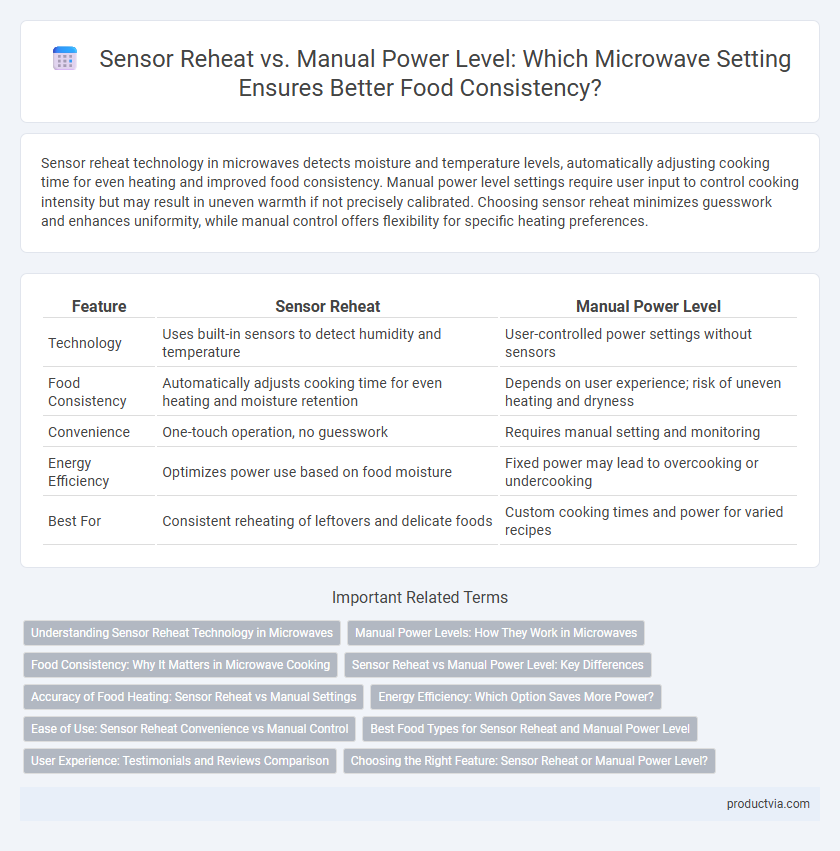Sensor reheat technology in microwaves detects moisture and temperature levels, automatically adjusting cooking time for even heating and improved food consistency. Manual power level settings require user input to control cooking intensity but may result in uneven warmth if not precisely calibrated. Choosing sensor reheat minimizes guesswork and enhances uniformity, while manual control offers flexibility for specific heating preferences.
Table of Comparison
| Feature | Sensor Reheat | Manual Power Level |
|---|---|---|
| Technology | Uses built-in sensors to detect humidity and temperature | User-controlled power settings without sensors |
| Food Consistency | Automatically adjusts cooking time for even heating and moisture retention | Depends on user experience; risk of uneven heating and dryness |
| Convenience | One-touch operation, no guesswork | Requires manual setting and monitoring |
| Energy Efficiency | Optimizes power use based on food moisture | Fixed power may lead to overcooking or undercooking |
| Best For | Consistent reheating of leftovers and delicate foods | Custom cooking times and power for varied recipes |
Understanding Sensor Reheat Technology in Microwaves
Sensor reheat technology in microwaves uses built-in humidity and temperature sensors to automatically adjust cooking time and power levels, ensuring optimal food consistency without the guesswork of manual settings. This technology detects steam emitted from food, fine-tuning power output to prevent overcooking or underheating, which often occurs with manual power level selection. Modern sensor reheating enhances convenience and deliver uniform results, preserving texture and flavor better than traditional manual microwave power adjustments.
Manual Power Levels: How They Work in Microwaves
Manual power levels in microwaves adjust the magnetron's duty cycle, controlling how long the microwave energy is emitted during the cooking process. Lower power settings cycle the magnetron on and off, allowing food to heat more slowly and evenly, which helps prevent overcooking or uneven textures. This precise control over energy output improves food consistency compared to sensor reheat, which relies on humidity sensors but may not always account for specific dish requirements or variations.
Food Consistency: Why It Matters in Microwave Cooking
Sensor reheat technology uses moisture and temperature sensors to automatically adjust cooking time and power, ensuring evenly heated food with optimal texture and taste. Manual power level settings require user input and may result in inconsistent heating, causing uneven texture or cold spots. Consistent food texture matters in microwave cooking as it preserves flavor, prevents overcooking, and maintains the desired moisture and tenderness of meals.
Sensor Reheat vs Manual Power Level: Key Differences
Sensor reheat technology in microwaves uses built-in humidity and temperature sensors to automatically adjust cooking time and power, ensuring more consistent and evenly heated food compared to manual power level settings. Manual power level reheating requires users to estimate the appropriate time and power, which can lead to uneven heating and inconsistent food texture. Sensor reheat enhances food consistency by adapting in real-time, while manual controls rely solely on user input without feedback from the food's actual condition.
Accuracy of Food Heating: Sensor Reheat vs Manual Settings
Sensor reheat technology in microwaves uses humidity and temperature sensors to automatically adjust cooking time and power levels, ensuring precise and consistent heating of food. Manual power settings require users to estimate the correct power level and cooking duration, which can lead to uneven heating or overcooking. Sensor reheat offers superior accuracy by adapting to food conditions in real-time, resulting in better texture and temperature uniformity compared to manual adjustments.
Energy Efficiency: Which Option Saves More Power?
Sensor reheat technology in microwaves utilizes humidity and temperature sensors to automatically adjust cooking time and power levels, optimizing energy use and reducing wastage. Manual power level settings require user input and often lead to overcooking or undercooking, resulting in inefficient energy consumption. Studies show sensor reheating can save up to 20% more energy compared to manual power adjustments, ensuring consistent food quality with better power efficiency.
Ease of Use: Sensor Reheat Convenience vs Manual Control
Sensor reheat technology simplifies microwave cooking by automatically detecting food moisture and adjusting power levels for consistent results, enhancing ease of use for busy individuals. Manual power level control offers precise customization but requires more user knowledge and involvement, potentially leading to inconsistent outcomes. Choosing sensor reheat ensures convenient, hands-free reheating, while manual control provides flexibility for tailored cooking preferences.
Best Food Types for Sensor Reheat and Manual Power Level
Sensor reheat technology in microwaves excels with foods high in moisture content, such as casseroles, soups, and leftovers, ensuring even heating without overcooking. Manual power level settings provide superior control for delicate items like eggs, fish, and baked goods, where precise temperature adjustments prevent texture degradation and maintain taste. Choosing sensor reheat optimizes convenience and consistency for common reheated meals, while manual adjustments are ideal for recipes requiring customized cooking intensity.
User Experience: Testimonials and Reviews Comparison
Sensor reheat technology in microwaves ensures optimal food consistency by automatically adjusting cooking time and power based on moisture levels, resulting in evenly heated meals without guesswork. User testimonials overwhelmingly highlight convenience and improved taste, contrasting with manual power level settings that often lead to uneven heating or overcooked edges due to imprecise adjustments. Reviews consistently favor sensor reheat for its ability to deliver restaurant-quality results effortlessly, enhancing overall satisfaction and reducing cooking errors.
Choosing the Right Feature: Sensor Reheat or Manual Power Level?
Sensor Reheat in microwaves uses built-in humidity and temperature sensors to automatically adjust cooking time and power, ensuring evenly heated food and reducing the risk of overcooking. Manual Power Level control allows users to customize microwave intensity for precise cooking needs, which is ideal for recipes requiring specific heat settings or gradual warming. Selecting between Sensor Reheat and Manual Power depends on convenience versus control: Sensor Reheat offers hassle-free consistency, while Manual Power Level provides tailored cooking for diverse food types.
Sensor Reheat vs Manual Power Level for Food Consistency Infographic

 productvia.com
productvia.com